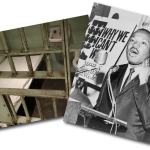 This Academic Webinar took place on Friday, Jan. 15, 2016 at 12 p.m. EST.
This Academic Webinar took place on Friday, Jan. 15, 2016 at 12 p.m. EST.
This live academic webinar will be presented by Tom Hastings, faculty in the graduate program of Conflict Resolution at Portland State University and an ICNC Academic Advisor.
This webinar is transcribed into Chinese
Watch webinar below:
Webinar content
1. Introduction of the Speaker: 00:00- 01:25
2. Presentation: 01:26 – 32:50
3. Questions and Answers: 32:51 – 53:59
Webinar Summary
This webinar looks at timeless lessons included in Dr. King’s letter dated on April 16, 1963, and smuggled out of a Birmingham jail where King and nearly 50 other protesters stayed imprisoned.
Dr. King participated in several movements in opposition to desegregation, finally even committing civil resistance, but had been primarily a movement spokesperson and strategic planner. In Birmingham, however, it was clear that the terrorists—the Ku Klux Klan and affiliated hoodlums, arguably the most violent in the US—were deterring most from participating in what was meant to be mass action, so on Good Friday 1963, King joined the demonstration, which became resistance when many protesters were arrested and King went to jail.
Eight Birmingham white clergy publicly criticized his actions and the demonstrations, calling them unwise and ill-timed. Four days later, King’s letter was made public which changed the national discourse then, and still provides important lessons for today’s social movements.
This webinar will primarily consider some of the generalizable concepts drawn from the letter, related to some of the issues and challenges of movements today.
You can follow us on Twitter directly (@nvconflict) or by searching for #ICNCWebinars. We will be live-Tweeting the webinar with Robert Press so come join us to ask questions for the presenter!
Presenter
 Tom Hastings, Ed.D., is co-coordinator of the undergraduate program in Conflict Resolution at Portland State University. He is a former member of the Governing Council of the International Peace Research Association (IPRA), former co-chair of the Peace and Justice Studies Institute, as well as the Academic Advisor Council of the International Center on Nonviolent Conflict. He is founding director of PeaceVoice, a program of OPI, and has written several books and many articles about nonviolence and other peace and conflict topics. He is a former Plowshares resister, a founding member of two Catholic Worker communities, and currently lives in Whitefeather Peace House.
Tom Hastings, Ed.D., is co-coordinator of the undergraduate program in Conflict Resolution at Portland State University. He is a former member of the Governing Council of the International Peace Research Association (IPRA), former co-chair of the Peace and Justice Studies Institute, as well as the Academic Advisor Council of the International Center on Nonviolent Conflict. He is founding director of PeaceVoice, a program of OPI, and has written several books and many articles about nonviolence and other peace and conflict topics. He is a former Plowshares resister, a founding member of two Catholic Worker communities, and currently lives in Whitefeather Peace House.
Recommended Readings
- Aeschliman, M. D. (2005). Enduring documents and public doctrines: Martin Luther King’s “Letter from Birmingham Jail” after forty years. Journal of Education, 186(1), 29-46.
- Berry, E. (2005). Doing time: King’s “Letter From Birmingham Jail”. Rhetoric & Public Affairs, 8(1), 109-131.
- Branch, Taylor (1998). Pillar of fire: America in the King Years 1963-65. New York, NY: Simon & Schuster.
- Chernus, Ira (2004). American nonviolence: The history of an idea. Maryknoll, NY: Orbis Books.
- Dyson, Michael Eric (2000). I may not get there with you: The true Martin Luther King Jr. New York, NY: The Free Press.
- Fisher, Roger, & Ury, William (2011). Getting to yes: Negotiating agreement without giving in. (3rd ed.). New York, NY: Penguin.
- Harding, Vincent (1996). Martin Luther King: The inconvenient hero. Maryknoll, NY: Orbis.
- Herman, A.L. (1999). Community, violence, & peace: Aldo Leopold, Mohandas K. Gandhi, Martin Luther King Jr., and Gautama Buddha. Albany, NY: State University of New York Press.
- Houck, D. W. (2004). Ed King’s jaw—or, reading, writing, and embodying civil rights. Rhetoric & Public Affairs, 7(1), 67-90.
- King, Jr., Martin Luther (1958). Stride toward freedom: The Montgomery story. New York, NY: Harper.
- King, Jr., Martin Luther (1963). Strength to love. New York, NY: Harper & Row.
- King, Jr., Martin Luther (1964). Why we can’t wait. New York, NY: Harper & Row.
- King, Jr., Martin Luther (1968). Where do we go from here: Chaos or community? New York: Bantam (original Harper & Row, 1967).
- Larson, D. (2010). Toward a prison poetics. College Literature, 37(3), 143-166.
- Lynd, Staughton & Lynd, Alice (1995). Nonviolence in America: A documentary history (2nd ed.). Maryknoll NY: Orbis Books (original 1966).
- McNeil, G. R. (2015). Martin Luther King, Jr: Diplomat, prophet, and global visionary. Journal of African American History, 100(1), 119-134.
- Miller, J. (2009). Integration, transformation and the redemption of America: The Fire Next Time and ‘A Letter from Birmingham Jail’. European Journal of American Culture, 28(3), 245-262. doi:10.1386/ejac.28.3.245_1
- Osborn, M. (2004). Rhetorical distance in “Letter from Birmingham Jail”. Rhetoric & Public Affairs, 7(1), 23-35.
- Patron J. (2004). A transforming response: Martin Luther King Jr.’s “Letter from Birmingham Jail”. Rhetoric & Public Affairs 7(1):53-65.
- Gaipa, M. (2007). A creative psalm of brotherhood”: The (de)constructive play in Martin Luther King’s “Letter from Birmingham Jail. Quarterly Journal of Speech, 93(3), 279-307. doi:10.1080/00335630701426769
- Rieder, Jonathan (2013). Gospel of freedom: Martin Luther King, Jr.’s Letter from Birmingham Jail and the struggle that changed a nation. New York, NY: Bloomsbury.
- Rosenberg, M. B. (2003). Nonviolent communication: A language of life (2nd ed.). Encinitas, CA: PuddleDancer Press.
- Walker, J. (1994). The body of persuasion: A theory of the enthymeme. College English, 56(1), 46-65.
- Zinn, Howard, et alia (2002). The power of nonviolence: Writings by advocates of peace. Boston: Beacon.